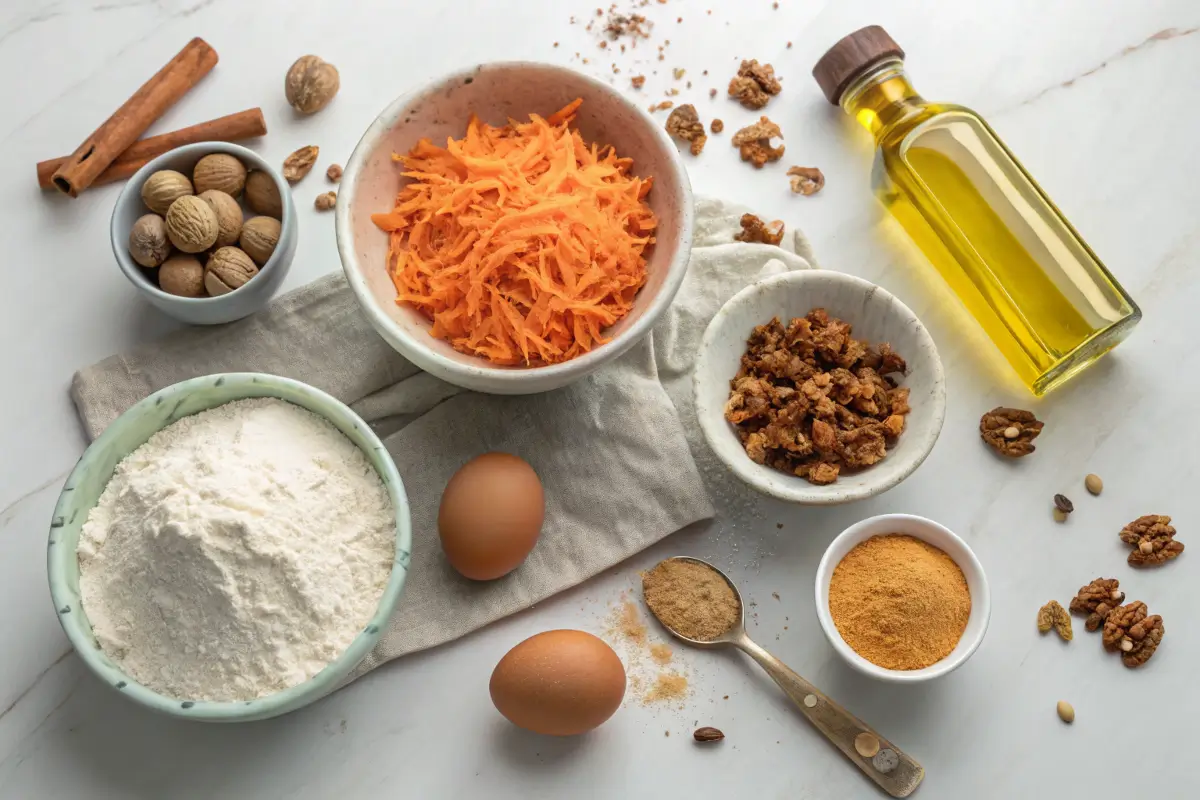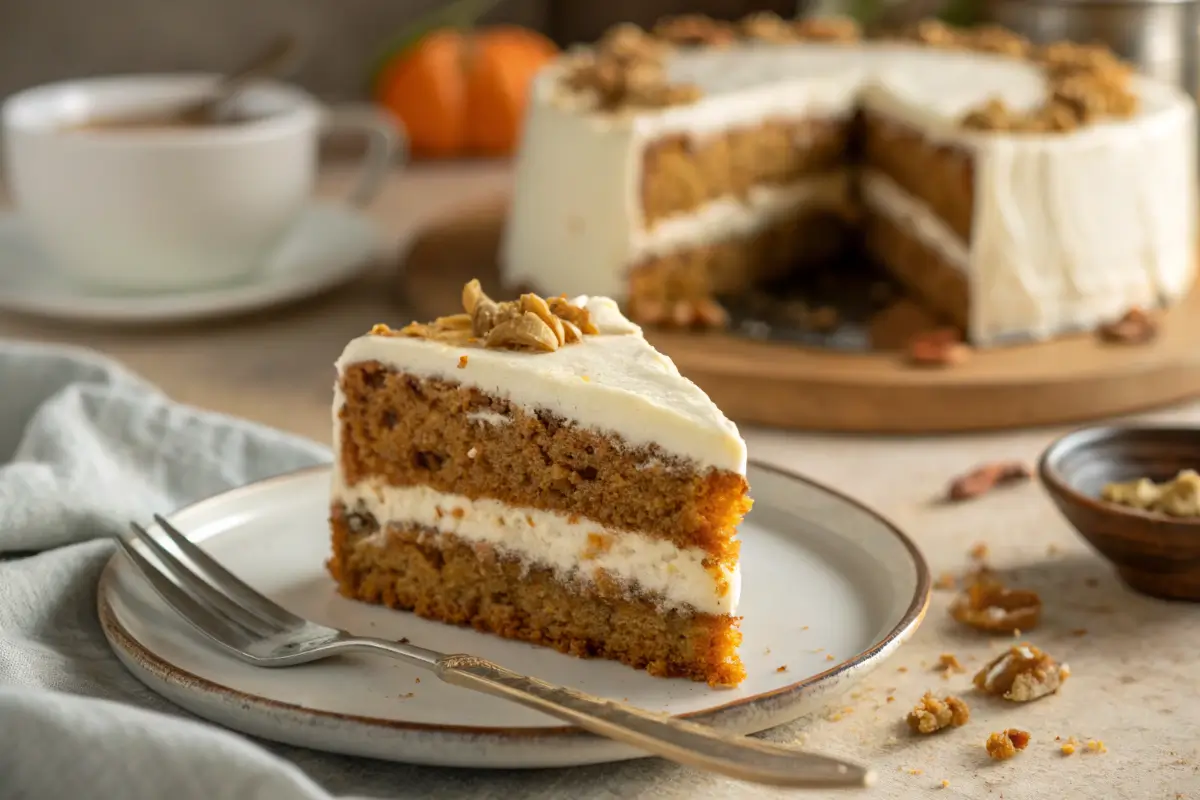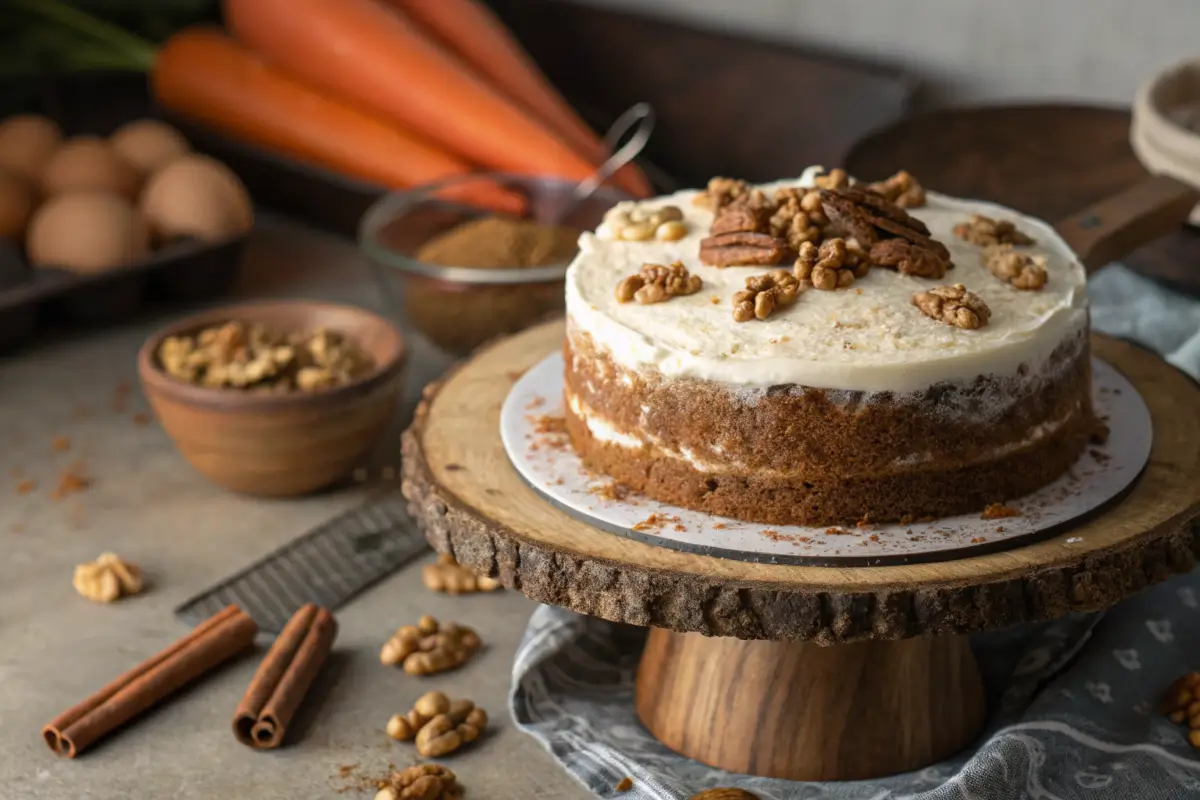Craving a slice of moist, delicious carrot cake, but you’re avoiding gluten? You’re definitely not alone! Searching for the perfect Gluten Free Carrot Cake Recipe? Many of us adore the comforting flavors of this classic treat, but need a gluten-free option. Because we know how important it is to get it right, this article is your complete guide to baking a truly amazing Gluten Free Carrot Cake. We’re going to unpack everything you need to know to bake a truly amazing gluten-free carrot cake at home. From picking the right flours to mastering that perfect cream cheese frosting, we’ve got you covered. Let’s get started and turn your kitchen into a gluten-free baking haven!
Introduction to Gluten-Free Baking & Carrot Cake
Why Choose Gluten-Free Baking?
For some, going gluten-free isn’t a choice, it’s a necessity. Conditions like celiac disease or gluten sensitivities mean that folks have to avoid wheat, barley, and rye. But even if you don’t have those concerns, baking gluten-free can actually be a fun and rewarding experience. It opens up a whole new world of ingredients and flavors. Plus, it allows you to share tasty treats with everyone, no matter their dietary needs.
The Allure of Carrot Cake: A Classic Favorite
Now, why is carrot cake such a winner? Well, it’s not just about the carrots! It’s the perfect balance of spices, the moist crumb, and that tangy cream cheese frosting on top that makes it so irresistible. Carrot cake is, quite simply, a comfort food classic. We all have fond memories of enjoying a slice at gatherings, and the idea of a gluten-free carrot cake recipe that can recapture that magic is something to get excited about, wouldn’t you say? It really is something special.
Gathering Your Gluten-Free Ingredients
Understanding Gluten-Free Flours for Carrot Cake
Baking a good gluten-free carrot cake recipe starts with understanding gluten-free flours, since they behave differently than wheat flour. Instead of relying on gluten for structure, you’ll often need a blend of flours to mimic that light, fluffy texture we all love. Almond flour, for instance, adds moisture and a slightly nutty flavor. On the other hand, tapioca starch helps with binding and gives the cake a bit of chewiness.
The Best Flour Blends for Light & Fluffy Texture
For a truly amazing texture, combining different gluten-free flours is key. A good blend might include rice flour for lightness, tapioca starch for binding, and a touch of sorghum flour for a more cake-like crumb. A premade gluten-free flour blend can also work wonders if you’re looking for convenience. Remember, not all blends are created equal so experiment to find what you like!
Essential Gluten-Free Baking Ingredients: Substitutions and Tips
Beyond flours, you’ll need a few other key items. Eggs provide structure and richness. Oil, like vegetable or coconut, makes the cake moist. Then there’s the matter of sweeteners; both white and brown sugars work well in carrot cake, as do some alternative sweeteners like maple syrup or honey. If you’re looking to swap sugar for something more natural, feel free to experiment!
Sweeteners & Spices: The Heart of Flavor
And speaking of flavor, don’t forget the spices! Cinnamon, nutmeg, and a touch of cloves give carrot cake its signature warmth. Also, don’t skimp on vanilla extract; it adds a lovely depth of flavor to your batter. If you enjoy incorporating nuts into your recipes, you might also like to try our almond nut cake recipe, which features a similar comforting flavor profile. The perfect blend of spices can really make or break your gluten free cake!
Step-by-Step Gluten Free Carrot Cake Recipe Instructions
Prepping Your Pans and Ingredients

Before you even think about mixing, it’s crucial to prep everything. First, preheat your oven. Then, grease and flour your cake pans (or use parchment paper). Next, measure out all your ingredients. Having everything ready to go makes the whole baking process much smoother, so that you don’t get caught without something midway.
Wet Ingredients: Combining for Optimal Moisture
In a large bowl, combine your wet ingredients. This usually includes eggs, oil, and any liquid sweeteners. Whisk them well until they’re light and combined. This part is important for ensuring even distribution of moisture and for creating a smooth base for our gluten-free carrot cake recipe.
Dry Ingredients: Whisking for Lightness
In a separate bowl, whisk together your gluten-free flour blend, baking powder, baking soda, spices, and salt. This step helps to distribute the leavening agents and spices evenly, which is vital for a well-risen and flavorful cake. Whisking well is crucial, as this adds air, helping with the end result of a lighter cake.
Combining Wet and Dry for a Perfect Gluten-Free Batter
Now, it’s time to gently add the dry ingredients to the wet ingredients. Mix on low speed, only until just combined. Be careful not to overmix, or you will have a dense cake. Then, fold in your shredded carrots, nuts, and any other add-ins.
Baking: Achieving the Golden Brown Perfection
Pour the batter into your prepared cake pans and bake until a toothpick inserted into the center comes out clean, or with only a few moist crumbs attached. This step requires patience but pays off big time.
Cooling Your Cake: The Crucial Step
Once out of the oven, let the cakes cool in their pans for a few minutes before turning them out onto a wire rack to cool completely. This is important for preventing the cake from breaking apart, and if you want to avoid a broken cake, you should be patient and allow it to cool. Once this step is done, you might want to consider other recipes for special occasions, such as a special butterfinger cake recipe, which offers a fantastic alternative to this cake.
Cream Cheese Frosting: The Perfect Pairing for Gluten-Free Carrot Cake

Ingredients for the Creamiest Gluten-Free Frosting
No gluten-free carrot cake is complete without a luscious cream cheese frosting. To make it, you’ll need cream cheese, of course. Make sure it’s softened for easier mixing. Also, you’ll need powdered sugar for sweetness and a little butter to give it a smooth consistency. Finally, a dash of vanilla extract will boost the flavor of the frosting.
How to Make the Perfect Cream Cheese Frosting
First, beat the softened cream cheese and butter together until they’re light and fluffy. This is a vital first step, as you’ll need a creamy, smooth base. Next, gradually add the powdered sugar, mixing on low speed to avoid a cloud of sugar! Once all the sugar is in, add the vanilla and continue mixing until the frosting is smooth and creamy. Taste and adjust the sweetness as you need to. This frosting is so good, you might want to lick the bowl!
Frosting and Assembling Your Gluten-Free Carrot Cake
Once your cake is completely cool, it’s time to frost it. Place one cake layer on a serving plate or cake stand, and spread an even layer of frosting on top. Then, gently place the second layer on top, and frost the entire cake. Finally, you can decorate it as you please, with some chopped nuts, shredded coconut, or even a dusting of cinnamon. This final flourish turns your homemade gluten-free carrot cake recipe into a true masterpiece!
Variations & Add-Ins for your Gluten-Free Carrot Cake
Adding Nuts and Dried Fruit for Texture
While the basic gluten-free carrot cake recipe is delicious on its own, adding some extra textures is always a great idea. Chopped walnuts or pecans offer a lovely crunch, while dried fruits like raisins or cranberries add a burst of sweetness and chewiness. Feel free to use your favorite nuts and dried fruits here!
Incorporating Tropical Flavors: Pineapple and Coconut
If you want to add a tropical twist, try incorporating crushed pineapple and shredded coconut into the batter. The pineapple adds extra moisture and sweetness, while the coconut gives a subtle exotic flavor. These additions can turn a basic recipe into something really special! If you enjoy this approach, we also have other simple recipes like our easy pumpkin dump cake recipe that might interest you.
Additionally, for another guide on how to satisfy your sweet tooth, check out our Taco Bell desserts guide, which includes ideas for a variety of different treats.
Spice Variations: Cinnamon, Nutmeg, and Cloves
While cinnamon, nutmeg, and cloves are the classic choices, don’t be afraid to experiment with other warm spices. A pinch of ginger or allspice can add a lovely depth of flavor. You can also play around with the ratios, using more or less of certain spices to create a flavor profile that suits your taste. It really is a great way to personalize your gluten-free carrot cake.
Tips for Gluten-Free Baking Success
Why Measuring Ingredients Precisely is Crucial
When it comes to gluten-free baking, accuracy is key. Unlike wheat-based recipes, gluten-free recipes can be much more sensitive to variations in ingredient amounts. Therefore, using a kitchen scale to measure your flours and liquids ensures you get the right consistency in your batter. Even a small difference can make or break your gluten free carrot cake recipe, so invest in a good kitchen scale if you’re doing a lot of gluten-free baking.
Troubleshooting Common Issues in Gluten-Free Baking
Sometimes, despite our best efforts, gluten-free baking can present some challenges. A dense cake can often be a result of overmixing the batter, or using a too heavy flour, while a dry cake might be due to incorrect measurements. If your cake is too crumbly, it could be because it lacks proper binding agents, or because you didn’t include enough wet ingredients. It’s all part of the learning curve, and knowing what to look for can certainly help you troubleshoot common problems, as you become more comfortable with gluten-free baking.
How to Store Your Gluten-Free Carrot Cake
If you manage to not eat the entire cake in one sitting, proper storage is important. Once completely cool, you can store your frosted gluten-free carrot cake in the refrigerator. This will keep the frosting fresh, as well as keep the cake moist. For longer storage, you can freeze individual slices, which can be thawed later. This will keep your cake tasting as great as if you just baked it!
FAQs
What is the best gluten-free substitute for cake flour?
For a light and tender crumb, a mix of rice flour, tapioca starch, and sorghum flour is a good choice, as these flours tend to work really well together, mimicking the delicate texture of cake flour. Also, you can look for ready-made gluten-free cake flour blends.
How do you add moisture to a gluten-free cake?
Moisture in gluten-free cakes can be tricky. The best strategy is to use oil instead of butter, add unsweetened applesauce, or incorporate buttermilk in the batter. Also, be sure to not overbake the cake, which can make it dry.
What is the key to successful gluten-free baking?
The key really lies in understanding how different gluten-free flours behave. Always measure your ingredients accurately, use room-temperature ingredients, and avoid overmixing the batter. Remember, practice makes perfect, so don’t give up if your first attempt isn’t spot on!
Why not use butter in carrot cake?
While butter gives flavor, it doesn’t contribute as much to the moisture in the cake. Oil does a better job in gluten-free baking, because it helps keep the cake moist and tender. This doesn’t mean that it’s never used but rather a better choice for a gluten-free cake like this one.
Enjoying Your Delicious Homemade Gluten-Free Carrot Cake
Final Thoughts and Encouragement
Well, there you have it! You’ve now got all the tools and knowledge you need to bake a truly amazing gluten-free carrot cake recipe. From carefully selecting your flours to mastering the cream cheese frosting, you’ve learned it all. It might seem a little daunting at first, but with a bit of practice, you’ll be whipping up gorgeous gluten-free cakes in no time. Remember, baking is all about experimentation and enjoyment. So, don’t be afraid to try new things and have fun with it, because the best part of baking is sharing what you create!
Recipe Card for Easy Reference
This section is a brief example of how to implement this into a recipe card format.
Gluten-Free Carrot Cake Recipe
Yields: 12 servings
Prep time: 20 minutes
Cook time: 30-35 minutes
Ingredients:
-
2 cups gluten-free all-purpose flour blend
-
1 tsp baking soda
-
1 tsp baking powder
-
1 tsp ground cinnamon
-
1/2 tsp ground nutmeg
-
1/4 tsp ground cloves
-
1/2 tsp salt
-
1 1/2 cups granulated sugar
-
3/4 cup vegetable oil
-
4 large eggs
-
2 tsp vanilla extract
-
3 cups grated carrots
-
1 cup chopped walnuts or pecans (optional)
Cream Cheese Frosting:
-
8 oz cream cheese, softened
-
1/2 cup unsalted butter, softened
-
3 cups powdered sugar
-
1 tsp vanilla extract
Instructions:
-
Preheat oven to 350°F (175°C). Grease and flour two 9-inch cake pans.
-
Whisk together the flour, baking soda, baking powder, spices, and salt.
-
In a separate bowl, combine sugar, oil, eggs, and vanilla.
-
Add the dry ingredients to the wet ingredients, mix until just combined.
-
Fold in carrots and nuts, if using.
-
Pour into pans and bake for 30-35 minutes, until a toothpick inserted in the center comes out clean.
-
Cool in pans for 10 minutes, then transfer to a wire rack to cool completely.
For the frosting:
-
Beat softened cream cheese and butter until smooth.
-
Gradually add powdered sugar, then vanilla extract. Mix until smooth.
-
Frost the cooled cake.
Nutritional Information
The following table shows approximate nutritional content per 100g of the finished cake (Note: these values are estimates and can vary based on exact ingredients used):
| Nutrient | Amount (per 100g) |
|---|---|
| Calories | Approx. 350-400 kcal |
| Total Fat | Approx. 20-25g |
| Saturated Fat | Approx. 8-12g |
| Cholesterol | Approx. 60-80mg |
| Sodium | Approx. 200-250mg |
| Total Carbohydrates | Approx. 40-50g |
| Dietary Fiber | Approx. 2-4g |
| Sugars | Approx. 25-30g |
| Protein | Approx. 3-5g |
Enjoy your delicious gluten-free carrot cake recipe! For a different take on techniques, the instructions included here might prove insightful.
Note: The nutritional information provided is an estimate. Actual values may vary depending on the specific ingredients used and the size of the slices.

